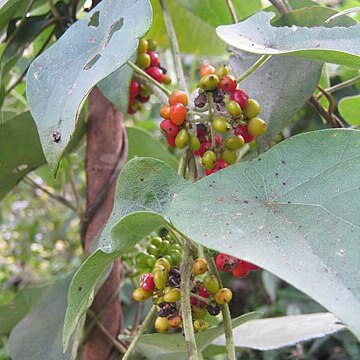Vines, glabrous or pubescent. Root woody, not tuberous, brownish yellow. Stems slender, slightly woody when old, sometimes prostrate and rooting at nodes. Petiole 3-12 cm; leaf blade conspicuously peltate, usually triangular-rotund or broadly triangular-ovate to rotund, 5-12(-15) cm, as wide as or slightly wider than long, papery to thinly leathery, abaxially glabrous or hirsute, often glaucous, adaxially glossy, base usually broadly rounded, apex with a finely mucronate acumen, palmately 8-11-veined, raised abaxially, reticulation slightly raised, conspicuous. Inflorescences compound umbelliform cymes, usually axillary, rarely 2 or few on short axillary branches; peduncle to 6 cm; rays often very short, umbellet very condensed, headlike; axes glabrous or pubescent; pedicels almost absent. Male flowers: sepals 6 or 8 in 2 whorls, membranous, yellowish green, oblanceolate or obovate-elliptic to spatulate or narrowly elliptic, 1-1.5 mm, glabrous or pubescent; petals 3 or 4, slightly fleshy, yellow, broadly obovate to rotund, 0.5-1 mm, glabrous, rarely apex slightly concave; synandrium 0.5-1 mm, exserted or not, anthers 6. Female flowers: sepals 3 or 4, shape and size as in male or smaller; petals 3 or 4, shape and size as in male or slightly smaller; carpel ovoid, stigma lacerate. Infructescences with hard and slightly curved umbellet pedicels. Drupes red, obovate to subglobose, 6-8 mm; endocarp 5-6 mm, abaxially ornamented with 10 or slightly more rows of transvers ridges; condyle perforate or not. Fl. spring and summer, fr. autumn and winter.
Root not tuberous. Leaves: petiole 3–12 cm long, attached 6–35 mm from basal lamina margin; lamina broadly triangular-ovate to ovate, 4–17 cm long, 4–14 cm wide, broadly rounded to slightly cordate at base, usually ± acuminate at apex, glabrous above, glabrous or puberulous below. Inflorescence a compound, umbelliform cyme, 4–9 cm long, glabrous or puberulous; flowers in dense clusters. Male flowers sessile or subsessile, white to cream; sepals 6 or 8, c. 1 mm long; petals 3 or 4, 0.5–1 mm long. Female flowers: carpel 0.75–1 mm long. Drupe usually sessile or subsessile, ± obovate in outline, 4–8 mm long, red; endocarp with dorsal transverse ridges, usually perforate.
A rather stout climber. The leaves are simple and the leaf stalk joins the blade away from the edge. Leaves are 4-18 cm long by 4-14 cm wide. The leaf stalks are 3-12 cm long. Plants are separately male and female. There are a group of flowers in the axils of leaves. The flowers have 2-4 petals. They are green, white or yellow. The fruit are fleshy and yellow, orange or red. They are 4-8 mm long and wide. There is one brown seed. It is 3-6 mm long.

